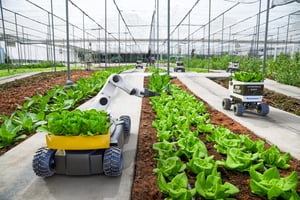Embracing This Age of Robotics
Robotics are changing the face of almost every industry, with the manufacturing sector appearing to benefit the most. In fact, some people refer to this age as the “fourth industrial revolution,” and for a good reason. If the current statistics are anything to go by, then you’d be right to say that we are in the age of robotics. On a global scale, data shows that a whopping 1.3 million industrial robots have made their way into factories.
Robots are designed to perform even the most complicated tasks, from moving materials on a job site to operating the production process, where they often handle dangerous duties that would otherwise be unsuitable for humans. They bring incredible precision, flexibility, and productivity to the workplace.
Let’s dig deeper and see the impact of robotics, particularly in manufacturing.
Use of Robotics in Manufacturing
There are different types of robots used in manufacturing process, with each assigned different tasks for increased productivity.
Material Handling Robots
The area where most of the world’s robots are used is material handling. They are programmed to automate unsafe, mind-numbing, and tedious tasks, such as part selection, palletizing, transferring parts, packing, and unloading.
Welding Robots
There are also robots programmed to do welding, both arc and spot welding. The idea of introducing these robots into the fabrication line is to achieve precision welding and cut down the cost and hours that would have otherwise been needed to handle large scale production. Offering the utmost efficiency, speed, reach, and load capacity, robots are welding parts of all sizes and shapes.
Assembly Robots
Assembly is another area where robots are commonly used, although not in large scale. In this segment, they handle disassembling, inserting, press-fitting, and fixing. They can be configured to satisfy specific demands of a factory, whilst maintaining quality and peak performance. Most robots are fitted with force sensing and vision systems that help guide them to pick up components, rotating or moving the pieces to fit them together.
Dispensing Robots
There’s also a small number of robots in manufacturing used for dispensing purposes, handling tasks such as spraying, applying adhesives, gluing, and painting. Thanks to their precision, speed, and consistent accuracy, they cut manufacturing time considerably and improve the overall quality of the products.
Material Removal Robots
Manufacturers that need to finish their products through routing, polishing, sanding, cutting, or grinding, usually use material removal robots. These kinds of robots are designed to refine product surfaces to perfect their quality. With automating material removal, manufacturers protect their workers from any harmful fumes or dust that may be released, increasing the safety level in their workplaces.
Inspection Robots
Inspection-based robots are not very common but have been on the rise because they detect flaws in different parts, guaranteeing accurate part assembly. Equipped with a vision system, these robots inspect all parts; concentrating even on small details such as measurements that the naked eye cannot see.
Benefits of Robotics in Manufacturing
Thanks to robotics, the manufacturing sector is on the verge of a major revolution. Technology is becoming more intelligent, cost-effective, and efficient, with robots being relied on to handle even more complicated tasks that are hard for humans to accomplish.
Here are some of the ways robotics are revolutionizing the manufacturing industry.
Improve Product Quality
Considering that robots conduct their tasks with superior repeatability and incredible precision, which would be hard to achieve any other way, they help improve the quality of products. Currently, there are robots that can accomplish repeatability of +/-0.22mm, with more upgrades expected to improve this reliability.
With better quality comes improved productivity. With robotics working continuously for hours without any interruptions or shift changes, they decrease part cycle times, speeding up production.
Automation Means Lower Cost
Through the use of robots, the complex processes through which products such as medical equipment are fabricated can be simplified significantly. With time, these robots are upgraded to be smarter, so they become more efficient focusing on precise and controlled movements, using less power, and generating little waste. To manufacturers, all these benefits cut costs and increase profit margins, making the entire production process less expensive.
Improved Working Environment
Industrial robots often perform complicated tasks that are deemed dangerous for humans. From mixing ingredients to precision cutting metal objects, the chance of injuries are much higher if handled by human workers. With proper programming, robots can handle any task and not suffer repetitive strain injury. Generally, the safety and working conditions in production plants are greatly improved.
Longer Working Hours
Typically, people working in manufacturing have to take breaks and sometimes get distracted, slowing their pace. Robots don’t tire. They can be programmed to work 24 hours per day, 7 days a week at the same pace. This means that the production line is continuous, with increased output all day long.
Job Opportunities
Some might argue that robotics cut down human jobs by taking over their tasks. While this has been the case in the past (to increase productivity and efficiency or processes), the truth is that the introduction of robotics also creates new job opportunities for people handling the robots. You see, these robots have to be programmed and continuously upgraded for more efficiency. All this is done by the human workforce. Furthermore, when unemployment rates are low manufacturers have difficulty finding qualified workers. Robots are vital to manufacturers, lest they have a labor shortage.
Competitive Edge
Manufacturers that embrace robotics are enjoying a competitive edge compared to those that have yet to fully adopt them. Considering that robots produce better quality products and meet demand, manufacturers are able to outdo their competitors.
Final Words
The world of robotics is a blessing to the manufacturing industry, and luckily it’s here to stay. With different kinds of robots programmed to perform a variety of tasks, from material handling and welding to assembly, dispensing and inspection, there’s no doubt robotics is the new age revolution in the manufacturing industry.
Manufacturers enjoy improved product quality, cut on their production costs, guarantee improved working environment for their workers, and of course, gain a competitive edge in the industry. Better yet, most robots in the manufacturing sector have been designed to collaborate with their human counterparts to increase the efficiency of the manufacturing process. It doesn’t matter what your factory manufacturers, you have to move with technology and embrace robotics wholeheartedly for the growth of your company.
Looking for more information on parts for your robot. Check out sdp-si.com, a leading mechanical components manufacturer providing engineered solutions for automation and robotic applications.



